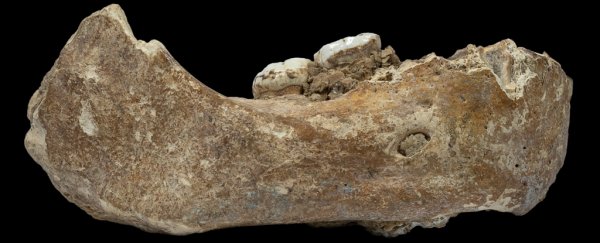A Denisovan jawbone has been discovered in a cave on the Tibetan Plateau, indicating that Homo sapiens were not the first humans to conquer such heights.
Previously known only through fossils from a Siberian Altai mountain cave, the Denisovans, a mysterious species of ancient humans, are considered a sister group to Neanderthals (H. neanderthalensis). This means both are thought to have evolved from a shared ancestral human species.
Just like the recent discovery of a tiny human species in the Southeast Asian islands, finding evidence of a Denisovan on the 4,500 metre (14,800 foot) high plateau shows human evolution was far more complicated than we thought, palaeoanthropologist Jean-Jacques Hublin from the Max Planck Institute for Evolutionary Anthropology in Germany explains.
"We have H. erectus - that was around probably 2 million years ago - groups of hominin Denisovans… then our species. Each time there was a little bit of admixture and replacement," Hublin said in a press briefing on the findings.
By admixture, Hublin means these different human species, including ours, had sex with each other. In doing so, we integrated genes from these ancient species into our modern human genome, with traces of Denisovan DNA detected in the local modern human populations, and in people as far away as Australia.
Most of what we know about Denisovans so far has come from DNA, which was sequenced from the bones in the Altai Mountain cave. This included a gene variant, or mutation, called EPAS1, which has been linked to the Himalayan people's ability to withstand hypoxia, the low-oxygen conditions found at high altitudes.
But as the previous Denisovan fossils had been found at an altitude of 700 metres, the reason they possessed these extreme environment genes had never been known.
"Until today, nobody ever imagined that archaic humans were able to dwell in such an environment," Hublin said, explaining that living in such challenging, high-altitude environments was thought to have been achieved only by modern humans like us, around 40,000 years ago.
"Denisovan-related populations probably lived for a long time in the Tibetan Plateau, and for this reason such a mutation became fixed in these fossil hominins and later passed on to modern invaders," Hublin said.
The newly discovered Denisovan fossil was actually found by a local monk back in 1980, and was eventually passed on to Lanzhou University. It consists of half the lower jaw, along with some intact large molars.
One of these molars had yet to fully erupt, Hublin pointed out, suggesting the jaw belonged to an adolescent Denisovan.
Proteomics researcher Frido Welker from Copenhagen University in Denmark described how the lack of preserved DNA meant they had to use proteins to identify which species the jaw belonged to.
The team were able to isolate eight different types of proteins that made up the collagen structure of the fossil, which were in fragments making up between 5 to 90 percent of their full structure.
This was enough to compare the proteins with those of other known hominin species, and to identify evidence that the proteins' amino acids most closely matched DNA from the Altai mountain Denisovan fossils.
Radioisotope dating placed the jaw at around 160,000 years old. In contrast the oldest evidence of H. sapien at these extreme altitudes had been dated to around 30,000 to 40,000 years ago.
"Archaic hominins occupied the Tibetan Plateau in the Middle Pleistocene and successfully adapted to high-altitude low-oxygen environments long before the regional arrival of modern Homo sapiens," said archaeologist Dongju Zhang from Lanzhou University in China.
She said the team is planning to revisit the Himalayan cave, which is also a holy site for the local people, in six months, and they hope to be granted permission for further excavation next year.
We can't wait to hear what else they find about our own ancient origins and the other humans we once shared our world with.
You can read the full description of this Denisovan discovery in Nature.
